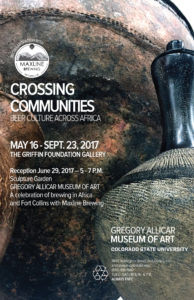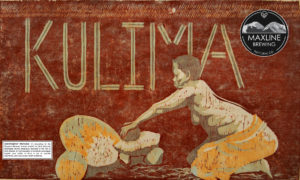[masterslider id=”258″]
To help celebrate a newly arrived collection of African beer vessels, Colorado State University students not only contributed to a museum exhibition but also designed the label for a special Maxline brew that will be served at a June 29 reception honoring the collection.
“Crossing Communities: Beer Culture Across Africa” opened at the Gregory Allicar Museum of Art on May 16 and runs through Sept. 23, in the museum’s Griffin Foundation Gallery.
The June 29 reception for the exhibition, being held from 5 to 7 p.m. in the outdoor Sculpture Garden at the University Center for the Arts, is a free, public event celebrating brewing culture in both Africa and Fort Collins.
About the event
“Crossing Communities: Beer Culture Across Africa”
June 29, 5 – 7 p.m., in the Sculpture Garden, UCA
Free, public event celebrating brewing culture in both Africa and Fort Collins
“My goal for this show was to demonstrate that, although we are in very different parts of the world, there are elements that cross over, and beer is one of those,” said senior art history student Laura Vilaret-Tuma. She co-curated the exhibition with David Riep, an assistant professor in CSU’s Department of Art and Art History. The exhibition features 39 vessels representing 26 different cultures and 17 countries around Africa; some of the pieces date back to the 19th century.
 The label
The label
Liz Griffin, an art education major who graduates in December, submitted the winning name and label design for “Kulima,” the special beer Maxline Brewing created for the celebration. Griffin says she chose the name — the Swahili word for “cultivate” — after researching the history of beer brewing in Africa.
“I thought about what brewing meant to their culture, and I liked the term ‘cultivate,’” said Griffin, who created the image using a woodcut that she carved in stages to produce four layers of color. She said she incorporated designs from several pots featured in the exhibition, after seeing some in person and others in photos sent by Riep. She spent about a month on the project; her winning design was selected in April.
Kulima features several of the ingredients found in traditional African beers: In addition to barley and hops, it contains millet, maize, gesho leaves and grains of paradise.
Linny Frickman, director and chief curator of the Gregory Allicar Museum of Art, said a portion of the collection of vessels associated with beer brewing, storage, drinking and ritual was given to the museum by an anonymous donor. The remainder of the collection was purchased with a monetary donation from Robert F. Bina and Delores DeWilde Bina, who have admired Riep’s work and funded the acquisition of some of the vessels in his honor.
The collection, which arrived at the museum last summer, also led to a $6,000 grant from the National Endowment for the Humanities to help pay for additional storage space needed for the vessels.

Made by women
Vilaret-Tuma, who would like to become a museum curator after she attends graduate school, said the vessels were made by hand — not using pottery wheels — by women employing techniques passed from mothers to daughters. She said her favorite section of the exhibition is the large beer-brewing and fermentation vessels that are more than two feet in diameter. While those vessels would be fired in above-ground kilns, she explained, during brewing they would be placed in the ground to keep the fermentation process cool.
Vilaret-Tuma said other distinctive pieces include vessels used not for drinking but for religious purposes: Before enjoying the brew themselves, Africans would set beer out for ancestors or gods to enjoy first.
“There is something magical about these vessels, and I wanted to showcase that,” she said. “With the lighting, we wanted to make it as ceremonial as possible, because it’s a big deal in Africa.”
Vilaret-Tuma added that co-curating the exhibition, a process that started almost a year ago, was a fantastic way for her to get a real-world taste of the career she plans to pursue.
“It was an amazing experience,” she said. “I learned so much from it.”
For more information, visit http://col.st/rP6Ts.